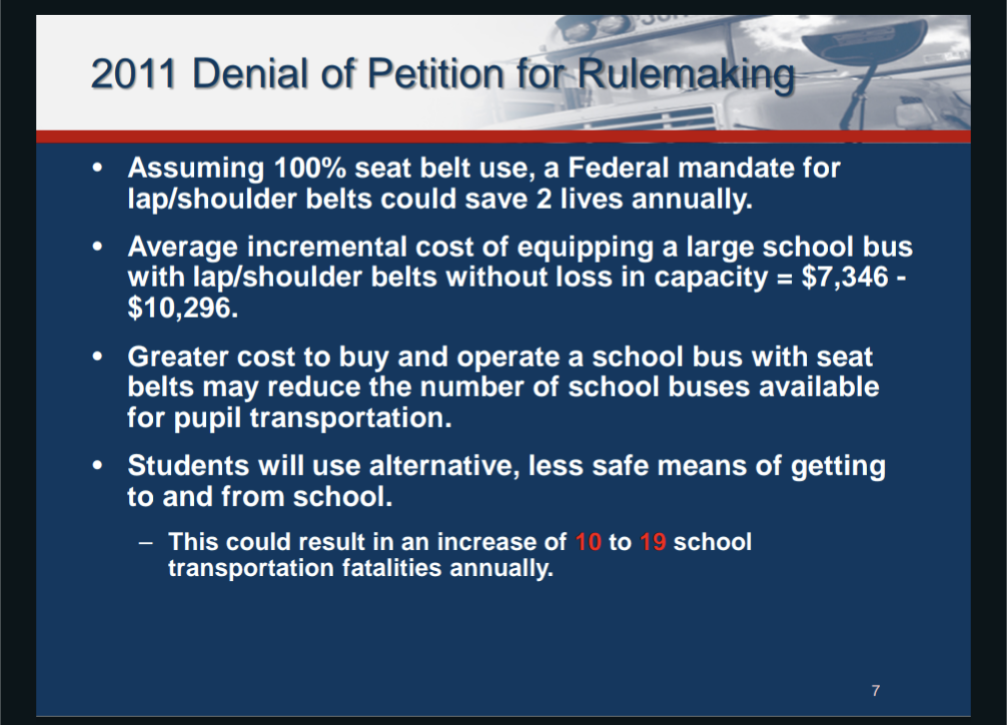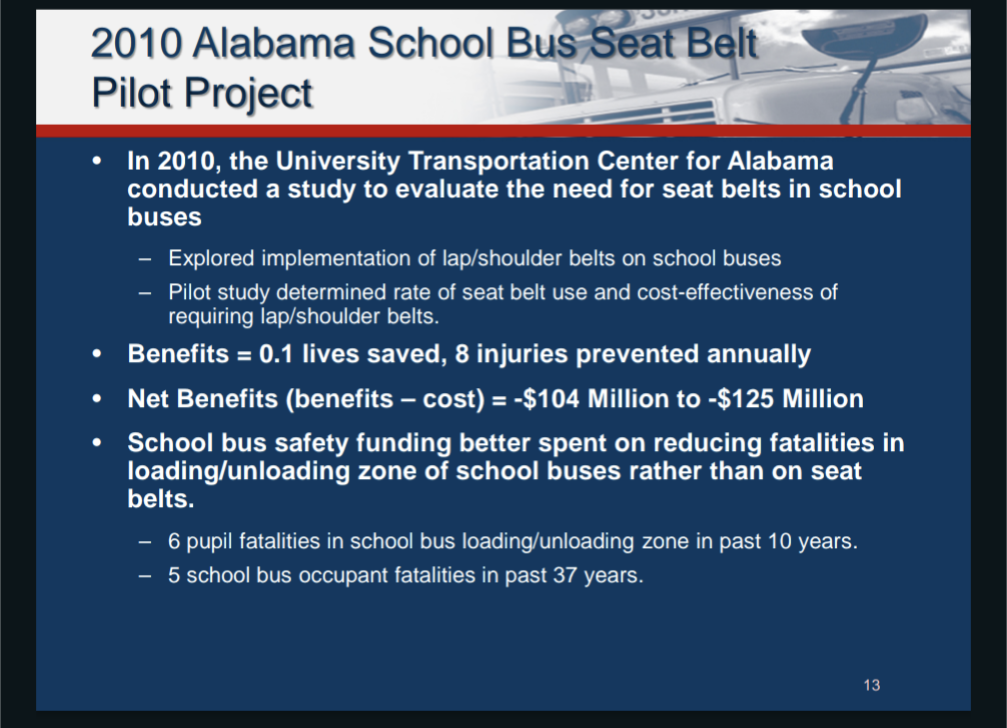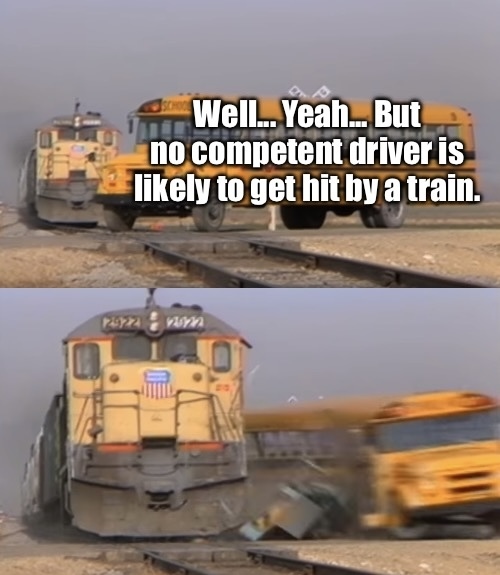Nah it’s so kids don’t get trapped in a fire
Nope, it’s literally a cost benefit analysis.


https://www.nhtsa.gov/document/seat-belts-large-school-buses
NTSB recommends seatbelts, NHTSA says they would save lives, but the cost or complexity might reduce usage, and school buses are safer than being dropped off at school, so the cost isn’t justified.
I mean, this is showing the school bus fatalities are insanely low (just 5 total in 37 years in AL) and we should instead use funding to make the more dangerous parts of student transportation safer. This seems like using data to make sure we are making informed choices that will actually increase safety for a larger number of kids instead of wasting resources.
That is precisely what it is.
It’s literally a cost benefit analysis showing that while seatbelts make riders safer, they aren’t thought to be the best way to make things as safe as possible.It’s not about fire safety.
Ok yeah that makes sense to me. Just when I heard it was because of a "cost benefit analysis " I think of some bigwigs saying “fuck them kids it’s too expensive to keep them alive”, vs the somewhat surprising reality here. Thanks for sharing.
Yeah, it’s a shame that the phrase cost benefit analysis has gotten a bad reputation.
Damn capitalist terminology! Capitalism is so good and then it had to create words to describe its shitty practices.
So the alternative is to not have any safety device. Got it. lmao
Well, it’s not “no” safety devices. There are strict rules about how high bus seats have to be, and how rigid so as to limit how far kids can fly in an accident, and to minimize injury when they get fired face first into the seat in front of them.
They also rely on the bus being much taller, and having far more mass than most vehicles, so kids are less likely to get tossed around.Like it said in the linked document, perfect seatbelt use was anticipated to save two lives a year in the US amongst school children, but spending that money on pick-up and drop-off safety would save more lives, and anything that made busses less available would cost them.
It’s largely moot, since more recent data says that it’s now worth it, and so the recommendation has shifted to adding them, although it’s not mandatory since it’s not a super powerful advantage.
It is still about fire safety. Fire fatalities are a part of the cost analysis. The implied cost of averting a fatality far outstrips the value of a statistical life. This is clinical language that’s used across government agencies and industries to evaluate the value of a policy or regulation.
It’s seriously not about fire safety, the data is right there as well as their rationale. The addition of seatbelts would save lives from bus accidents, but likely increase fatalities from decreased ridership.
NHTSA believes the cost in lives and dollars isn’t justified given the data.Also, it looks like they reevaluated, and now believe that they are worth it given new information.
Yeah, and fatalities due to fire is part of the calculation. You can’t possibly think that all of the data they used to reach the determination is in a fucking slide deck, right? These people are smarter than you, don’t make the mistake of assuming the opposite.
No, they don’t omit seatbelts because of fire safety, and you can tell because their numbers say that including seatbelts would increase the numbers of lives saved.
Who said anything about them being dumb? People said “no seatbelts because fire safety”, and a summary of the NHTSA policy rationale saying “seatbelts would save lives, but the money would be better used elsewhere” is a rebuttal to that.
Are you somehow thinking I’m saying the NHTSA doesn’t look at fire data?
In other words, divert funding from school bus seatbelts to Safe Routes to Schools.
Usually seat belts are made to be ejected by a simple button and spring mechanism. We perfected the technology decades ago.
Cool. Now try to get a 1rst grader to use one when it’s panicking
What would they do in a real car owned by mom and dad? Presumably in a child booster seat? Do children usually have issues with seatbelts? Also, in a head on collision, that 1st grader is going to be travelling at 40-60mph head first into seat in front of them.
If you don’t know if children have issues with seatbelts or not, maybe you shouldn’t even be in the condo, homie
The driver won’t have time to unfasten 40 seat belts if there’s a fire. Most collisions involving a bus will be against a much smaller vehicle, so the bus won’t slow down as harshly as a smaller car would.
deleted by creator
It’s not actually fire concern.
https://www.nhtsa.gov/document/seat-belts-large-school-buses
That’s a summary of the NHTSA stance pre 2015.
Tldr: busses are super safe, and much safer than other ways if getting to school. Eliminating the problem that seat belts solved would not be reducing fatalities or injuries by much.
Mandating seatbelts would also likely reduce ridership due to costs or difficulty managing seatbelts in kids, and since buses are safer, reducing ridership does more harm than seatbelts prevent.
More kids get hurt by people driving recklessly around dropoff and pickup sites than in bus accidents, so focusing on that issue does more good.Also, in 2015 the NHTSA reversed their position. They didn’t mandate it though, so it’s taking a while for states to retrofit busses.
Changing data, changing policy.
deleted by creator

deleted by creator

deleted by creator
Train has entered the chat
Which is why protocol is to stop before the tracks and open the door to listen
The CBC’s “The Fifth Estate” did a whole show about this.
People are doing all kinds of justifications to why school buses don’t have seatbelts, but why don’t regular public transportation buses have seatbelts?
Because they are friggin tanks. 63000 pounds of you can’t hurt shit unless you are bigger. Which in a fixed route system is rare. Because bigger things are on the freeway and busses are on surface streets.
I was a bus driver. I have been in two accidents. One a car was upset and rammed my rear left panel. Took off his bumper. It didn’t even chip my paint and no one was harmed in the coach.
It’s up to the operator almost always if their passengers are harmed. There are exceptions. But if you are operating at the speed limit and just on the designed route there are few times where people will be in harms way inside the bus. In fact to make good time for the route and the passengers it’s usually safe to go 5 mph under the posted speed limit.
I assumed it was kids cant beat each other with them
Is the reasoning for the comic, like it’s cheaper for a funeral cost than someone who survives and incur cost during recovery not including the chance for a lawsuit on both scenario?
The actual reasoning by the NHTSA is that busses are statistically safer than other methods of getting to school, and that adding and requiring seatbelts reduces ridership, which pushes students to less safe ways of getting to school, and also costs money that isn’t justified by the number of lives and injuries saved.
Statistically, a human life in the US is worth about $7.5 million. So if your intervention costs $8 million and only saves one life, then you’re in the hole $500 thousand.
You are expansive guys…
I thought you meant expensive, but given the obesity epidemic, the sentence works either way.
Hahaha, expensive expandable expendables!
But yeah, I meant expensive
Makes you wonder why the driver gets a seatbelt when the kids do not.
Because an adult should know how to unbuckle themselves in a rollover accident.
And the driver is at a different impact point
In a rollover accident, you also risk kids getting tossed around like clothes in a dryer and ejected from the vehicle if the windows are open or break. I can’t say I think that is a better option. It is a risk vs reward scenario here. In a fire you can get out easier, in a rollover, you turn the bus into a drink mixer if it is going fast enough into the roll.
I’m willing to trust the people who designed them and the fact that they’ve continued with the same design over the thinking of a random person on the internet
Like all things, it’s complicated and you’re both right. For a long time the best practice was to not have them.
The numbers now say it’s better to have them, and more places are recommending that they do.
Yep! As we gather more data we draw new conclusions and solutions!
The back of the seat if front of the students is higher and softer than the steering wheel in front of the driver.
As unfortunate as it sounds, in most accidents kids can’t bounce around much and mostly hit something soft enough to keep injuries minor or at least nonfatal.For a long time the numbers worked out that that was enough for most bus accidents to protect students, and that seatbelt costs would be better spent increasing safety at pickup and dropoff locations and increasing bus ridership numbers, since even without seatbelts a school bus is radically safer than being driven to school or walking in most places.
More recently, the numbers have started to say we should invest in seatbelts and making pedestrian routes to schools safer, since those would now make a more significant impact.
Nightmare on Lem Street







